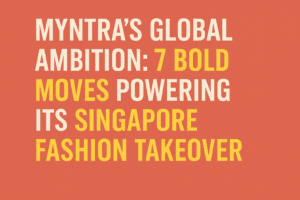Myntra’s Global Ambition: 7 Bold Moves Powering Its Singapore Fashion Takeover
Bengaluru-based e-commerce giant Myntra has launched Myntra Global, marking its international debut with a strategic focus on Singapore’s 650,000-strong Indian diaspora. The move capitalizes on the community’s demand for culturally resonant fashion, offering ethnic wear, fusion styles, and beauty products from popular Indian brands like Sabyasachi and Anouk. Singapore’s affluent Indian population, contributing to over 30,000 monthly organic visitors to Myntra’s platform, signals untapped potential for curated homegrown trends. Leveraging third-party logistics partners, the company aims to deliver orders within 4–7 days, balancing speed and cost in a competitive market dominated by giants like Lazada and Amazon.
CEO Nandita Sinha emphasizes the platform’s role as a “cultural bridge,” blending nostalgia with commerce by connecting overseas Indians to their heritage through fashion. While challenges like shipping costs and local rivalry persist, Myntra’s niche focus on authentic Indian designs positions it to carve a unique space. Success in Singapore could pave the way for expansions into larger diaspora markets like the U.S. or UAE, transforming regional brands into global contenders. This strategic play highlights the growing clout of hyper-targeted, emotion-driven e-commerce in a borderless retail landscape.

Myntra’s Global Ambition: 7 Bold Moves Powering Its Singapore Fashion Takeover
Bengaluru-based e-commerce giant Myntra has set its sights beyond Indian borders, marking its international debut with the launch of Myntra Global and a strategic entry into Singapore. The move targets the city-state’s 650,000-strong Indian diaspora, a community increasingly seeking ways to stay connected to cultural roots while living abroad. This expansion isn’t just about selling products—it’s a calculated effort to leverage nostalgia, identity, and the rising demand for homegrown fashion trends in global markets.
Why Singapore? Strategic Roots Meet Spending Power
Singapore’s Indian population, making up nearly 9% of its residents, represents a blend of cultural loyalty and purchasing power. Myntra’s decision aligns with broader trends in cross-border e-commerce, where diasporas drive demand for locally cherished brands. The platform has already seen organic traction, with over 30,000 Singapore-based users browsing monthly—a signal of latent demand for Indian ethnic wear, fusion styles, and beauty products.
“For Indians abroad, fashion is more than clothing; it’s a thread to their heritage,” says Myntra CEO Nandita Sinha. By curating collections from homegrown labels like Sabyasachi, Anouk, and H&M India, Myntra aims to transform occasional shopping trips into habitual engagement, positioning itself as a cultural bridge rather than just a retailer.
Navigating Competition and Logistics
While Myntra’s focus on Indian fashion carves a niche, Singapore’s crowded e-commerce landscape poses challenges. Giants like Lazada and Shopee dominate general retail, while Amazon.sg offers fast delivery. Myntra’s edge lies in specialization: authentic Indian products rarely available elsewhere. However, success hinges on execution.
Logistics remain critical. Myntra plans to partner with third-party cross-border logistics firms to promise deliveries within 4–7 days—a tight window for international shipping. Costs and reliability could make or break customer loyalty. Competitors like Nykaa, which expanded to the UAE and Australia, faced similar hurdles but leveraged localized marketing to gain traction. Myntra might need to follow suit, perhaps offering bundled shipping or exclusive launches for overseas customers.
The Bigger Picture: A Blueprint for Global Growth
Singapore serves as a testing ground for Myntra’s broader ambitions. The company hints at “new customer segments” and “international brand affinity,” suggesting future moves into markets like the U.S., UK, or Canada, where Indian expatriate communities are larger but more dispersed.
Industry experts note that diaspora-focused commerce is booming. Platforms like Patak Store (for Indian groceries) and Zee5 Global (for regional content) have shown that catering to cultural cravings pays off. Myntra’s challenge is differentiating in a sector where global players like Amazon and Shein also stock Indian attire but lack curated assortments.
Cultural Connection as Commerce
Myntra’s launch underscores a shift in global retail: the rise of hyper-targeted, emotionally resonant commerce. For overseas Indians, access to festive wear, traditional jewelry, or even trending streetwear from home isn’t just convenient—it’s a way to preserve identity. Myntra’s bet is that this emotional draw will translate into loyalty, even if prices are steeper than local alternatives.
As cross-border e-commerce grows—projected to hit $4.1 trillion globally by 2030—Myntra’s Singapore foray could set a precedent. If successful, it may inspire other Indian platforms to look outward, transforming local brands into global phenomena. For now, all eyes are on whether Myntra can stitch together logistics, culture, and demand into a seamless global tapestry.
You must be logged in to post a comment.